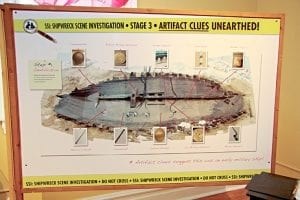BY DON RICKERS Special to the VOICE
Artifacts, models, pictorial displays, and a virtual reality experience of a British warship that participated in the Battle of Lake Erie during the War of 1812 are being featured at the Welland Museum.
Museum curator Penny Morningstar said that the HMS General Hunter was the museum’s first marine shipwreck exhibition. She had originally planned for a scale model, a physical replica of the ship’s excavated hull to be built by volunteers and placed on display, but financial and logistical issues precluded the project. Instead, she opted for a “three-dimensional experience” which allows the viewer to enjoy a virtual reality tour of the ship, as it would have existed in the early 1800s.
Derek Schneider of Nauta Design Group created the virtual model and app for the exhibit, which can be viewed using a tablet, laptop computer, or VR headset. Nauta is also a corporate sponsor of the event.

Ken Cassavoy, a nautical archaeologist who now resides in Welland and sits on the museum’s board of directors, was the driving force behind HMS General Hunter’s restoration.
“I love this little ship. I’ve lived with it now for almost 20 years,” he said. “The exhibit is such an education for young people. They learn the significance not just of this ship, but of how it was connected to battles during the War of 1812 that occurred in and around the Niagara region.”
Built at Amherstburg, Ontario in 1806, HMS General Hunter was a two-masted brig built of solid oak, and manned by a crew of 28 under the command of Lieutenant George Bignell. She measured 54 feet long and 18 feet wide, with a displacement of 93 tons, and possessed an armament of 10 cannons.
General Hunter was captured by the Americans during the Battle of Lake Erie in the waters off Put-In Bay, Ohio, when the British fleet surrendered. Renamed Hunter, she served her new masters for several years plying the upper lakes as a supply vessel.
Hunter was sailing from Michilimackinac to Detroit in August, 1816 when a violent storm on Lake Huron threw the ship off course, and the crew ran her aground near Southampton, with no loss of life. American seamen salvaged what they could from the wreck before abandoning it. The hull lay buried under the beachside sand for almost two centuries. Low water levels and retreating winter ice exposed tips of the wooden ship’s skeleton in 2001, and Cassavoy’s preliminary excavation commenced shortly thereafter in an attempt to identify the ship.
It became obvious that the ship was quite old, and, because of its age, a significant piece of history. Based on the hull construction and the artifacts found, Cassavoy knew they had a military vessel from the late 18th or early 19th century, but her name was still a mystery.
Cassavoy’s investigation uncovered important details of the ship in the U.S. National Archives in Washington, DC. Remarkably, a complete story of the demise of the ship was documented by the crew and master of the Hunter, and was preserved in the national archives.
Because the ship’s remains are so close to the shoreline, a temporary berm was constructed during the excavation to keep waves from washing onto the site. But after three weeks of digging, the berm gave way, and within hours the ship was completely reburied. Once a sturdier berm of concrete blocks had been erected, the digging began again, carried out by Cassavoy and a large group of volunteers spearheaded by the Southampton Marine Heritage Society.
A full interior excavation of the hull in 2004 provided hundreds of artifacts, which have all been conserved and restored by the Canadian Conservation Institute in Ottawa. The artifacts and a 3⁄4-size ship deck replica of General Hunter are on permanent display at the Bruce County Museum and Cultural Centre in Southampton, Ontario.
HMS General Hunter’s hull remains buried in the Lake Huron sand, where it is stable and safe. Removing the hull from water, after the aged wood has been saturated for 200 years, would cause what remains to rapidly deteriorate.
The exhibit also includes information and models of two other famous War of 1812 shipwrecks, Hamilton and Scourge, which to this day sit upright in 300 feet (92 metres) of water off Port Dalhousie in Lake Ontario.
The exhibit runs April through December. The Welland Museum is open Tuesday through Saturday, 10 am – 4 pm.


